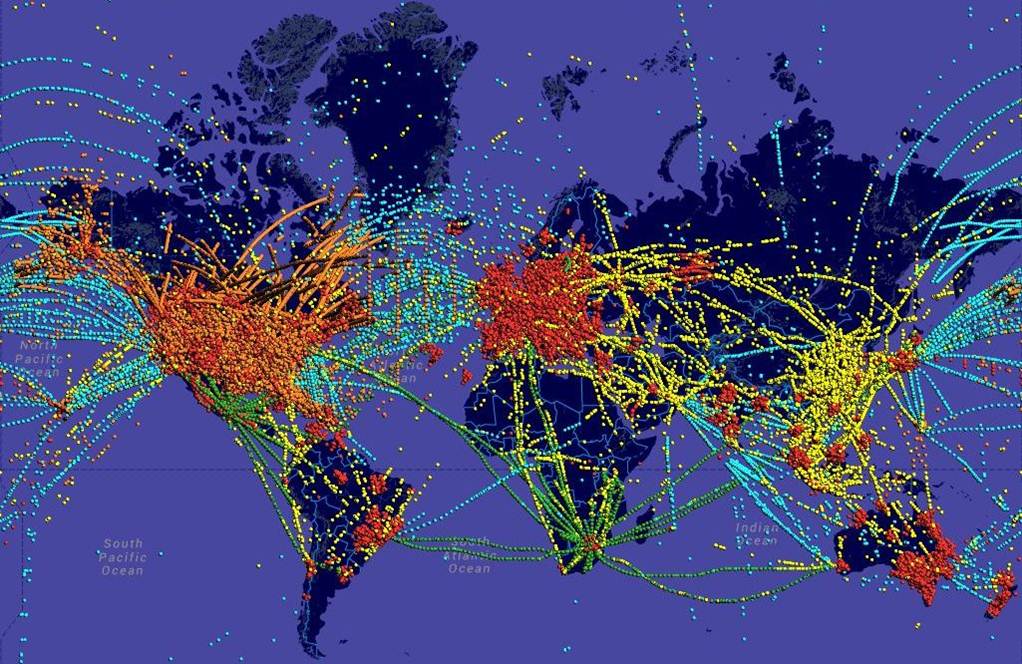[Avionics Today 03-10-2015] On March 9, the anniversary of the disappearance of Malaysian Airlines flight MH370, Rockwell Collins debuted its new ARINC MultiLink flight tracking solution, which unites six different data feeds from both the aircraft and air traffic sources. The new technology merges data from avionics systems and capabilities already on board the aircraft as well as position data from Eurocontrol and Rockwell Collins own network performance tracking products to allow airlines and operators to access more comprehensive and frequent tracking data.
 |
| Flight tracking map, the colored dots represent different data sources captured by Rockwell Collins MultiLink. Photo: Rockwell Collins |
“We are well aware of the fact that so much of the recent dialogue started with the disappearance of the Malaysian aircraft a year ago,” said David Poltorak, vice president of information management services at Rockwell Collins, during a webinar introducing the new technology early Monday morning. The aircraft disappearance sparked the International Civil Aviation Organization (ICAO) and the International Air Transportation Association’s (IATA) Aircraft Tracking Task Force to lay out new tracking standards requiring aircraft flying in remote areas not covered by air traffic radar surveillance to have technology on board that reports their position every 15 minutes.
“Multiple data feeds can allow [the operator], in the aggregate, to provide the positional data more frequently than one could by itself,” said Tim Ryan, director of GLOBALink programs and services management, during the webinar. “If you focus on just one [data stream] you may not have enough information to satisfy even the 15-minute recommendations by ICAO. With the aggregate of all [data streams] together, you certainly do.”
ARINC Multilink does this by combining the multiple data sources to report the location of an aircraft anywhere in the world. These sources include: Automatic Dependent Surveillance-Contract (ADS-C), Automatic Dependent Surveillance-Broadcast (ADS-B), High Frequency Data Link (HFDL) performance data, U.S. Aircraft Situation Display to Industry (ASDI) radar data, Eurocontrol position information, and Aircraft Communications Addressing and Reporting System (ACARS) position reports.
“If you look at all these different data feeds they all have different format, they have different content. That’s what makes it difficult for the carriers in the past to actually use that data. [The data] is very difficult to gather to begin with and then to harmonize into a common feed that they can use for their operations has been difficult,” said Ryan. “We will actually do that. We will create a feed coming out of the feed server that allows us to standardize the format and the content of each of the positional data blocks so they can be readily identified by any application that may want to use this feed.”
MultiLink will combine these streams as well as other information to report the aircraft’s current position as well as the departure location and destination of the aircraft, the flight ID and the equipment type, or make and model of the plane. The technology also has the ability to determine if an aircraft goes silent, possibly sooner than traditional transponder-based tracking.
“If an aircraft goes silent, we will know,” said Ryan. “If you only have one data feed, and that’s the only thing you’re looking at, it may take you a while to realize … But if I’m looking at multiple — 3, 4 — data feeds and they all go silent, then I have a much quicker way of determining there is a problem, potentially, with the aircraft or on the flight deck.”
Rockwell Collins’ December acquisition of aerospace communication services company ARINC also plays a role in bringing the tech to term. The MultiLink system’s ground-based High-Frequency Data Link (HFDL), which automatically delivers network performance data on equipped aircraft, originated in ARINC, now the Information Management Services (IMS) division of Rockwell Collins, and will be repurposed for the use of aircraft tracking. The information was previously used to troubleshoot problems aboard the aircraft post-flight, but MultiLink will pull and use the information directly. “Now we’re not post-processing it; we’re taking a direct, real-time feed and pulling it into this tracking mechanism,” said Ryan.
For now, the system is available only to airlines and operators in the air transport market, but Ryan told Avionics Magazine that the company doesn’t discount eventually offering the service to Air Navigation Service Providers (ANSPs) for surveillance purposes. He also believe the system could eventually be useful in the general aviation arena, although it will bring along its own challenges and “unique data feeds.”
Looking ahead, the system makes room for future data sources, possibly pulling from feed information provided by satellite companies Inmarsat and Iridium in the future, which Ryan says have already indicated interest in providing additional data to carriers.
“We expect to identify other sources of positional data that can be repurposed for aircraft tracking in the future,” Ryan told Avionics Magazine. “There will be new satellite and broadband technologies that will certainly bring more diverse data to bear on the issue. There are other technologies that have nothing to do with tracking that can provide positional data. In short, there are a lot of smart and innovative people working in this space.”